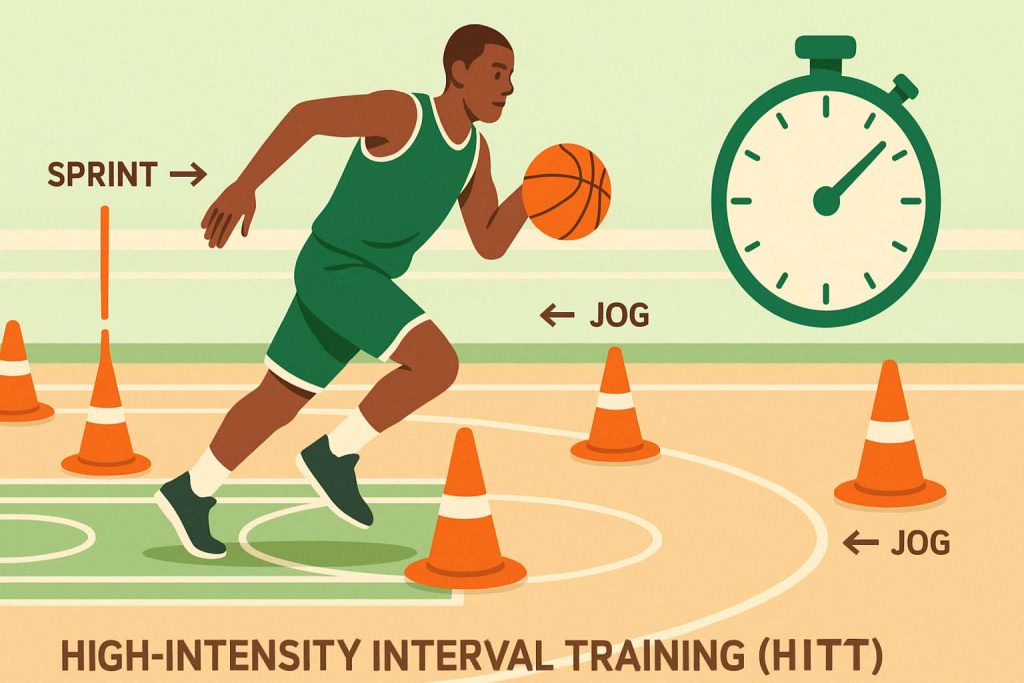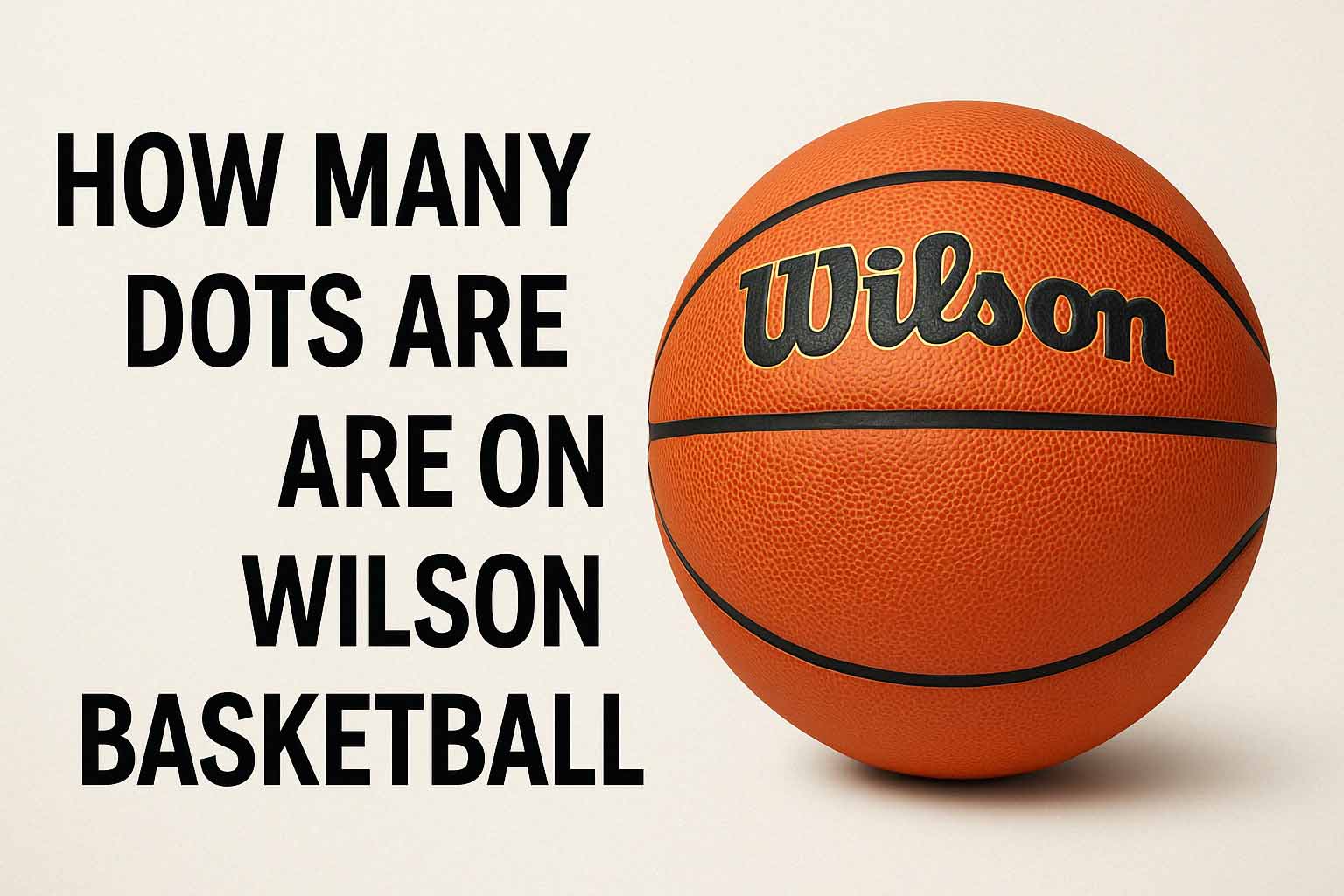If you’ve ever played a full game of basketball and found yourself gasping for air halfway through the second quarter, you’re not alone. I’ve been there. Back when I first started taking basketball seriously, I could barely keep up after the first few minutes of play. I quickly learned that skill alone wasn’t enough—you need stamina to stay sharp and explosive until the final buzzer.
Basketball isn’t just about flashy dunks or deep three-pointers—it’s a high-octane, fast-paced sport that demands full-body endurance. Whether you’re sprinting in transition, locking down your man on defense, or cutting hard to get open, your stamina is what keeps you in the game both physically and mentally.
In this guide, I’ll walk you through exactly how to improve stamina for basketball using real-world tips, targeted workouts, and recovery strategies that work. These are the same methods I’ve used and recommended to players who want to stay strong from tip-off to overtime. So if you’re tired of fading out in the second half or just want to level up your performance, stick with me—this guide is for you.
Up next, I’ll break down why stamina matters so much in basketball, and what it actually means for your game beyond just being able to run longer. Let’s get into it.
Contents
- 1 Why Stamina Matters in Basketball
- 2 Assessing Your Current Fitness Level
- 3 Best Exercises to Improve Stamina for Basketball
- 4 Nutrition and Hydration for Peak Stamina
- 5 Recovery: The Secret Weapon for Improving Stamina
- 6 Basketball-Specific Drills for On-Court Endurance
- 7 Mental Toughness and Focus
- 8 Long-Term Progress and Monitoring
- 9 FAQ Section
- 10 Conclusion
Why Stamina Matters in Basketball

Role of Stamina in a High-Intensity Sport Like Basketball
Basketball isn’t a slow game—it’s a mix of speed, agility, and non-stop movement. One minute you’re sprinting down the court, the next you’re fighting for a rebound or diving for a loose ball. It’s intense. And without solid stamina, you’ll start to feel drained fast.
I remember my first time playing in a competitive league. I had the skills, but by halftime, I was gassed. My shots were short, my defense sloppy. That’s when I realized: if you want to play well in all four quarters, you need more than talent—you need endurance.
Stamina helps you stay active on both ends of the court. It allows you to recover quicker between plays, maintain focus, and make smart decisions—even when your legs are burning. Whether you’re playing pickup or pushing through a full-court press, having better stamina means you can do more with less effort.
According to Harvard Health, endurance training boosts oxygen delivery to your muscles. That means more energy for you during every game, every quarter.
Difference Between Stamina and Strength
People often mix up stamina and strength. While they’re both important, they serve different purposes on the court.
Strength is about power. It helps with explosive moves—like jumping for a dunk, boxing out, or holding your ground in the paint.
Stamina, on the other hand, is about staying power. It’s what helps you keep moving, stay alert, and avoid fatigue during a full game. You can be strong and still run out of gas if your stamina isn’t there.
Think of it this way: strength is your burst, stamina is your engine. You need both, but stamina is what keeps you in the game longer.
Common Signs of Poor Stamina During Games
You might not even notice your stamina slipping—until it hits you mid-game. Here are a few clear signs that your endurance needs work:
- Breathing hard after just a few sprints
- Struggling to keep up on fast breaks
- Fatigue setting in by the second quarter
- Poor shot selection when tired
- Slower reaction time on defense
- Lack of energy to contest shots or grab rebounds
If you’ve felt any of these during games, you’re not alone. The good news is, stamina can be improved with the right plan—and that’s exactly what we’ll cover in this guide.
Assessing Your Current Fitness Level
How to Evaluate Your Endurance
Before you start training, it helps to know where you’re at. I always tell players—know your baseline, then build from there.
Here are some simple but effective ways to check your current stamina level:
- The Beep Test (or Yo-Yo Test): This test measures your aerobic fitness by having you run back and forth between two points at increasing speeds. It’s widely used in sports training. You can find a digital version or app for it easily. Check out TopEnd Sports for a full breakdown.
- 1-Mile Run Test: Time yourself running a mile at a steady pace. This gives you a basic idea of your cardiovascular endurance.
- Heart Rate Recovery Test: Measure how quickly your heart rate drops after intense exercise. A faster drop usually means better conditioning.
These tests are easy to do and give you real numbers to track progress.
The Importance of a Fitness Baseline
Think of your fitness baseline as your personal scorecard. Without it, you won’t know if you’re actually improving.
When I started tracking my own fitness, I was shocked at how inconsistent I was from week to week. Once I had clear numbers from tests like the beep test and mile run, I could see what needed work and how much I was improving over time.
It also keeps you motivated. Watching your numbers go up—even a little—feels like winning.
Sample Stamina Evaluation Metrics for Basketball Players
Here’s a simple table I’ve used with players to track their stamina:
| Test | Excellent | Good | Needs Improvement |
| Beep Test Score | 13+ levels | 10–12 levels | Under 10 levels |
| 1-Mile Run Time | Under 6:30 minutes | 6:30–8:00 minutes | Over 8:00 minutes |
| Heart Rate Recovery | >30 bpm drop in 1 min | 22–30 bpm drop in 1 min | <22 bpm drop in 1 min |
These benchmarks aren’t perfect for everyone, but they’re a solid starting point. Use them to see where you stand and where you want to go.
Best Exercises to Improve Stamina for Basketball

Interval Training and HIIT
One of the fastest ways I improved my stamina for basketball was by adding interval training to my workouts. I’m talking about high-intensity interval training (HIIT)—short bursts of intense movement followed by a short rest. It mimics game situations perfectly.
In basketball, you don’t run at one pace the whole time. You sprint, stop, change direction, jump, and go again. HIIT conditions your body to handle this stop-start intensity.
Here’s a quick HIIT routine I’ve used:
- Sprint 30 seconds
- Rest 30 seconds
- Repeat 8–10 times
You can also check out this HIIT guide from Verywell Fit to understand the benefits and structure of interval workouts.
It’s hard at first—but it works. I noticed better endurance in just two weeks of doing this.
Endurance Running (Aerobic Base Building)
Before you master those quick bursts, you need a solid aerobic base. That’s where endurance running comes in. It’s simple, steady, and helps build your lungs and legs.
I used to run for 20–30 minutes at a moderate pace three times a week. It wasn’t flashy, but it paid off big time during long games or tournaments.
Long runs improve your aerobic capacity, which means your body can deliver oxygen to your muscles more efficiently. This keeps you going longer without burning out.
The American Heart Association recommends aerobic training for better heart health—and it directly boosts your stamina on the court.
Jump Rope Routines
Jumping rope might look basic, but it’s one of my favorite stamina tools. It builds coordination, foot speed, and endurance—all in one workout.
I started with just a few minutes a day and slowly added time. Now I can go for 10–15 minutes without missing a beat.
Try this simple routine:
- Jump 1 minute
- Rest 30 seconds
- Repeat for 10 rounds
What I love most? You can do it anywhere. No court needed. It’s especially great for warming up before a game.
Want to learn more? Crossrope has an awesome breakdown of how jump rope helps with full-body conditioning.
On-Court Conditioning Drills (Suicides, Zig-Zag Sprints, etc.)
Nothing beats on-court drills for basketball-specific stamina. These drills train your body to move the way you do during a game—side-to-side, forward, backward, and quick transitions.
Here are a few of my go-to drills:
- Suicides: Sprint from the baseline to each line and back (free throw, half court, etc.)
- Zig-Zag Sprints: Mimic defensive slides with directional changes
- Full-Court Layup Drill: Sprint and finish at the rim, rebound, and repeat
These workouts simulate game pressure and build muscle memory. When I was training for a tournament, I did these 3 times a week, and I felt like I had an extra gear on game day.
Weekly Basketball Stamina Workout Plan
Here’s a sample weekly workout plan I’ve used and recommend for building stamina:
| Day | Workout | Focus |
| Monday | 30-minute endurance run | Aerobic base |
| Tuesday | HIIT (sprints 10x30s on/30s off) + Jump rope | Speed, recovery, coordination |
| Wednesday | On-court drills (suicides, zig-zags) | Game-specific conditioning |
| Thursday | Rest or light activity (stretching, yoga) | Recovery |
| Friday | Interval run (2 min fast/1 min slow x 6) | Threshold endurance |
| Saturday | Full-court layup drill + jump rope | Basketball-specific stamina |
| Sunday | Optional rest or low-impact cardio | Active recovery |
Nutrition and Hydration for Peak Stamina
Foods That Enhance Endurance (Complex Carbs, Lean Proteins, etc.)
Food is fuel. When I started focusing on what I ate—not just how I trained—I noticed a huge change in my energy levels.
For stamina, your body needs complex carbohydrates, lean protein, and healthy fats. These foods provide long-lasting energy and help your muscles recover faster.
Here’s what I usually eat before a game or intense training:
- Complex carbs: Brown rice, oats, sweet potatoes
- Lean protein: Chicken, turkey, eggs
- Healthy fats: Avocados, nuts, olive oil
The Cleveland Clinic has a helpful breakdown on pre-workout fueling if you want to dive deeper.
Also, don’t skip breakfast on training days. A balanced meal in the morning sets the tone for your stamina later.
Importance of Hydration Before, During, and After Games
You can train all day—but if you’re dehydrated, your stamina takes a hit. I learned this the hard way during a summer league game when I started cramping mid-second quarter. I had barely drunk any water that day.
Hydration affects your energy, focus, and performance. Make sure you:
- Drink water regularly throughout the day
- Hydrate 1–2 hours before your game
- Sip during breaks
- Rehydrate after with water or electrolyte drinks
According to Johns Hopkins Medicine, even mild dehydration can affect your mood and focus—not what you want when you’re chasing down a fast break.
Supplements (If Any) to Consider
Supplements aren’t magic—but they can help if used wisely. I’ve used a few to support my stamina, especially during intense training weeks.
Here are some worth considering:
- Electrolyte powders or tablets (especially in hot weather)
- BCAAs (branched-chain amino acids) for recovery
- Caffeine (pre-game, in small doses) to boost alertness
- Beta-Alanine (for reducing muscle fatigue)
Of course, talk to a trainer or doctor before adding anything to your routine. The National Institutes of Health (NIH) has a detailed database on dietary supplements that I use when researching any new product.
Recovery: The Secret Weapon for Improving Stamina
Role of Sleep in Endurance and Muscle Repair
I used to think pushing myself 24/7 was the only way to get better. But the truth is, recovery is where the magic happens—especially when it comes to building stamina.
Sleep is the number one tool for recovery. When you sleep, your body repairs muscle tissue, restores energy, and balances your hormones. I noticed a huge jump in my endurance once I started getting 7–9 hours of sleep consistently.
According to the Sleep Foundation, proper sleep improves focus, reaction time, and stamina. That’s everything you need to dominate on the court.
So don’t treat sleep like a bonus—it’s part of your training.
Importance of Rest Days
Rest days aren’t a sign of weakness—they’re part of a smart training plan. When I skipped them, I ended up tired, sore, and stuck in a performance rut.
Your body needs time to recover from all that running, jumping, and sprinting. Without rest, you can’t build stamina—you just wear yourself down.
I usually schedule 1–2 rest days each week, depending on how intense my workouts are. These days give your muscles and nervous system time to reset.
The Mayo Clinic actually recommends active rest over doing nothing—so you stay loose without overdoing it.
Active Recovery Ideas (Light Jog, Yoga, Swimming)
Active recovery changed how I train. It’s not about sitting on the couch—it’s about moving gently to promote recovery and keep blood flowing to tired muscles.
Here are my favorite active recovery methods:
- Light jog or brisk walk
- Gentle yoga or stretching
- Swimming (low impact, great for joint relief)
- Foam rolling (amazing for sore legs)
If you’re new to yoga, Yoga Journal has great beginner routines focused on stretching and flexibility.
Active recovery helps prevent soreness and keeps your stamina gains from slipping away.
Basketball-Specific Drills for On-Court Endurance
Full-Court Drills to Mimic Game Intensity
You can run track all day, but if you want true basketball stamina, you need to train like you play. That’s why full-court drills are key.
When I coached a summer league team, we ran drills that mimicked game speed and game movement. The goal was to build endurance and decision-making under pressure.
Here are two of my go-to full-court drills:
- Full-Court Layup Relay: Players sprint full-court, finish at the rim, and jog back
- Transition Defense Drill: Sprint to midcourt, turn and defend a fast break
These simulate real plays and force your body to recover quickly between intense bursts—exactly like a real game.
Defensive Slide Drills and Rebounding Under Fatigue
Endurance isn’t just about offense—it’s about staying sharp on defense when you’re gassed. That’s why I include defensive slide drills in every stamina-focused session.
These build lateral quickness, core strength, and focus under fatigue.
Try this simple routine:
- Set two cones 10 feet apart
- Slide side-to-side between them for 30 seconds
- Rest 15 seconds
- Repeat 5 times
For rebounding, I simulate fatigue by doing sprints first, then jumping for back-to-back rebounds for 30 seconds straight. It forces your body to work while tired—just like the fourth quarter.
Here’s a great article on basketball defensive drills if you want to expand your workout options.
Game Simulations During Training
One of the most effective stamina boosters I’ve used is game simulation. This means replicating real match situations—intensity, movement, and timing—during practice.
For example, I’ll run:
- 3-minute scrimmages at full pace, with minimal breaks
- Situational drills like pressing defense or last-minute offense
- Fatigue drills, where players run sprints before shooting free throws
This builds mental and physical stamina—because when your body’s tired, your brain needs to stay sharp. It’s also a fun way to train because it feels like real basketball.
Top 5 Basketball Drills to Improve In-Game Stamina
Here’s a list of the drills I’ve personally used and recommend for improving endurance during games:
| Drill Name | Purpose | How to Do It |
| Full-Court Layup Relay | Sprint + scoring under pressure | Sprint to the hoop, finish, jog back, repeat |
| Defensive Slide Drill | Lateral movement under fatigue | Slide side-to-side for timed rounds |
| Rebound & Sprint Circuit | Recovery + vertical endurance | Sprint + rebounding in short intervals |
| 3-Minute Game Scrimmage | Simulated game play under fatigue | Play at full speed for 3 minutes with minimum rest |
| Transition Defense Drill | Conditioning + court awareness | Sprint back and defend fast breaks repeatedly |
Mental Toughness and Focus
How Mindset and Concentration Affect Stamina
Here’s something I’ve learned through years of playing and coaching—your body can only go as far as your mind allows it.
I’ve seen players with insane physical ability break down in the fourth quarter. Not because they weren’t strong, but because they didn’t believe they could keep going. That’s why mental stamina is just as important as physical stamina.
Staying calm and focused during tough games helps you conserve energy, avoid mistakes, and push through fatigue. According to Psychology Today, concentration and mental resilience are key for peak athletic performance.
So don’t just train your body—train your brain too.
Visualization and Breathing Techniques
One trick I’ve always used before big games is visualization. I close my eyes and picture myself running up and down the court, finishing layups, locking down on defense—even when I’m tired.
This mental rehearsal helps my brain prepare for what’s coming, so I don’t panic when I’m actually in that moment.
Breathing techniques are another great way to stay sharp. Deep breathing helps you stay calm, lower your heart rate, and keep your energy steady. Try this:
- Breathe in through your nose for 4 seconds
- Hold for 4 seconds
- Breathe out through your mouth for 6 seconds
- Repeat 5–10 times
This simple routine has helped me stay focused during high-pressure plays. For more structured breathing tips, Headspace offers great guided exercises you can try before or after workouts.
Staying Motivated During Tough Games or Practices
Motivation doesn’t always come easy—especially when your legs are burning, and there are still 10 sprints left.
What keeps me going is remembering why I started. Whether it’s making the varsity team, impressing college scouts, or just beating last week’s personal best, I focus on the long-term goals.
I also break tough practices into mini goals—like just finishing one more drill or making one perfect pass. These small wins build momentum.
And honestly, having a good playlist helps too. Music can fire you up and keep your energy flowing. Science backs this up too—Harvard Health says music boosts mood and endurance during workouts.
Long-Term Progress and Monitoring
Tracking Improvements (Journal, Apps, Fitness Trackers)
I always say, if you’re not tracking it, you’re guessing. And when it comes to stamina, even small progress is worth celebrating.
I like to use a fitness journal or tracking app to record:
- How long I run or train each day
- My heart rate before and after workouts
- Notes on how I felt—energized, tired, focused, etc.
You can also use apps like Strava, Nike Training Club, or a basic fitness watch to track progress. Seeing the data helps you stay motivated and spot what’s working (and what’s not).
When and How to Scale Up Training
Once you’ve been training for a few weeks and feel stronger, it’s time to level up. But go slow and steady.
Here’s what I recommend:
- Add 5–10% more time or distance each week
- Introduce harder drills gradually (like longer suicides or more game-time scrimmages)
- Keep listening to your body—especially your joints and muscles
Progress should feel challenging, not painful. If your body feels wrecked every day, that’s a sign to pull back a little.
A helpful rule is the 10 Percent Rule, which suggests increasing training by no more than 10% per week to avoid injury.
Avoiding Burnout and Injury Prevention Tips
I’ve seen too many players burn out from going too hard, too fast. You can only grind for so long before your body—and your mind—need a break.
To avoid burnout:
- Take at least one full rest day each week
- Mix in light days with heavy ones
- Cross-train with activities like swimming or biking
- Sleep enough and eat well
Injury prevention is also key. Always warm up before workouts and stretch afterward. Use foam rollers or massage guns to keep muscles loose.
And don’t ignore pain. Sharp or lingering pain is your body saying, “Something’s wrong.” Trust me—taking a few days off is better than being sidelined for months.
For more info, check out these injury prevention tips from the CDC.
FAQ Section
Q1: How long does it take to improve basketball stamina?
Great question. From my experience and the players I’ve worked with, most people start noticing real changes in their stamina within 3 to 4 weeks of consistent training.
That said, it depends on your starting point. If you’re new to exercise, give it a little longer. Stick to a solid plan of cardio, strength, and on-court drills. If you stay consistent, your endurance will absolutely improve.
Want to track your progress better? Check out how fitness progression works with consistent overload.
Q2: Can I improve stamina without running?
Absolutely, yes.
While running is one of the most common ways to boost stamina, there are plenty of other options. I’ve worked with athletes who used swimming, cycling, jump rope, and HIIT workouts to build endurance just as effectively.
You can even train stamina with bodyweight circuits or low-impact cardio routines, which are easier on the joints but still boost your heart rate.
Q3: What’s the difference between stamina and endurance in sports?
They’re very close, but not quite the same.
Stamina is your ability to keep going with strength and energy—both physically and mentally. It’s about how long you can perform at your best without fading.
Endurance, on the other hand, is more about your body’s physical capacity to perform over time. It includes both cardiovascular endurance (heart and lungs) and muscular endurance (how long your muscles can work before they’re tired).
If you’re curious about the science behind it, Healthline explains it well.
Q4: How often should I train for stamina as a basketball player?
In my routine, I usually aim for 3 to 5 stamina-focused sessions a week, depending on the season.
- Off-season: Go harder—4 to 5 days per week of endurance and strength
- In-season: Dial it back—2 to 3 days to avoid fatigue during games
Balance is key. Mix in rest days, recovery drills, and strength work so your body doesn’t break down. Trust me, quality matters more than just quantity.
You can use this training load calculator to help manage weekly workload without overdoing it.
Q5: Is weightlifting necessary for stamina improvement?
Not necessary—but it definitely helps.
You don’t need to lift like a powerlifter, but building strength supports your stamina. Stronger muscles fatigue slower, and you’ll recover faster between plays.
Focus on compound movements like squats, lunges, deadlifts, and core work. These exercises help with both stamina and injury prevention.
If you’re new to the gym, this beginner strength guide is a good starting point.
Conclusion
Recap of Key Methods to Boost Stamina
Let’s bring it all together. Improving your basketball stamina isn’t about doing one thing perfectly—it’s about combining smart habits that build over time. Here’s a quick recap of what we covered:
- Start with a fitness baseline so you know where you stand
- Mix in interval training, running, and basketball-specific drills
- Eat well—focus on complex carbs, lean protein, and proper hydration
- Prioritize recovery and sleep
- Train your mind as much as your body
Encouragement to Stay Consistent
If there’s one thing I’ve learned, it’s that results come from consistency—not intensity. Even on the days when it feels tough, showing up matters.
You won’t see huge changes overnight. But stick with it, and one day you’ll be running the court with ease, wondering how it ever felt hard.
 Sports Daily Info All Things Sports, from News to Match Schedules
Sports Daily Info All Things Sports, from News to Match Schedules



